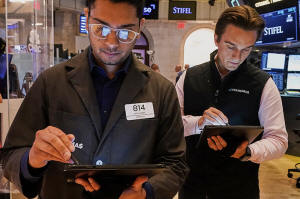Wall Street is split as Tesla and tech drop while most other US stocks
climb
[July 02, 2025] By
STAN CHOE
NEW YORK (AP) — A mixed day of trading left the U.S. stock market split
on Tuesday as Wall Street’s momentum slowed after setting record highs
in each of the last two days.
The S&P 500 dipped 0.1% for its first loss in four days. The Dow Jones
Industrial Average rose 400 points, or 0.9%, and the Nasdaq composite
fell 0.8%.
Tesla tugged on the market as the relationship between its CEO, Elon
Musk, and President Donald Trump soured even further. Once allies, the
two have clashed recently, and Trump suggested there’s potentially “BIG
MONEY TO BE SAVED” by scrutinizing subsidies, contracts or other
government spending going to Musk’s companies.
Tesla fell 5.3% and was one of the heaviest weights on the S&P 500. It
has lost just over a quarter of its value so far this year, 25.5%, in
large part because of Musk’s and Trump’s feud.
Drops for several darlings of the artificial-intelligence frenzy also
weighed on the market. Nvidia’s decline of 3% was the heaviest weight on
the S&P 500.
But more stocks within the index rose than fell, led by several casino
companies. They rallied following a report showing better-than-expected
growth in overall gaming revenue in Macao, China’s casino hub. Las Vegas
Sands gained 8.9%, Wynn Resorts climbed 8.8% and MGM Resorts
International rose 7.3%.
Automakers outside of Tesla were also strong, with General Motors up
5.7% and Ford Motor up 4.6%.
All told, the S&P 500 slipped 6.94 points to 6,198.01. The Dow Jones
Industrial Average rose 400.17 to 44,494.94, and the Nasdaq composite
fell 166.84 to 20,202.89.

The overall U.S. stock market has made a stunning recovery from its
springtime sell-off of roughly 20%. But challenges still lie ahead for
Wall Street, with one of the largest being the continued threat of
Trump’s tariffs.
Many of Trump’s stiff proposed taxes on imports are currently on pause,
and they’re scheduled to kick into effect in about a week. Depending on
how big they are, they could hurt the economy and worsen inflation.
Washington is also making progress on proposed cuts to tax rates and
other measures that could send the U.S. government’s debt spiraling
higher, which could raise inflation. That in turn could mean higher
interest rates, which would hurt prices for bonds, stocks and other
investments.
Despite such challenges, strategists at Barclays say they see signals of
euphoria among some investors. The strategists say a measure that tries
to show how much “excess optimism” is in the market is not far from the
peaks seen during the “meme stock” craze that sent GameStop to
market-bending heights or to the dot-com bubble at the turn of the
millennium.
Other signals include demand for what are known as “blank-check
companies,” which are essentially piles of cash that hunt for privately
held companies to buy. When too much optimism is in the market, it can
inflate stock prices to too-high levels in what’s called a “bubble.”
[to top of second column] |

Trader Niall Pawa, left, works with a colleague on the floor of the
New York Stock Exchange, Tuesday, July 1, 2025. (AP Photo/Richard
Drew)
 Of course, “market bubbles are
infamously difficult to predict and can endure far longer than
anticipated before correcting,” according to the Barclays
strategists led by Stefano Pascale and Anshul Gupta.
In the bond market, Treasury yields swiveled following some mixed
reports on the U.S. economy.
One said U.S. employers were advertising more job openings at the
end of May than the month before and than economists expected. That
could be an encouraging signal for a job market that had been
appearing to settle into a low-hire, low-fire state.
Separate reports on U.S. manufacturing were more mixed. One from the
Institute for Supply Management said U.S. manufacturing activity
shrank again in June, though not by as much as the month before.
“Customers do not want to make commitments in the wake of massive
tariff uncertainty,” one survey respondent in the fabricated metal
products industry said.
A separate report from S&P Global suggested manufacturing production
returned to growth in June after three months of declines.
The yield on the 10-year Treasury held at 4.24%, where it was late
Monday, after bouncing from a modest loss to a modest gain earlier
in the day.
The two-year Treasury yield, which more closely tracks expectations
for what the Federal Reserve will do with its main interest rate,
rose more sharply to 3.77% from 3.72%. Better-than-expected data on
the economy could push the Fed to stay on pause with interest rates,
after it halted its cuts to rates at the start of this year.
Fed Chair Jerome Powell said again on Tuesday that he wants to wait
for more evidence about how Trump’s tariffs will affect the economy
and inflation before resuming cuts to interest rates. That’s despite
Trump’s angry insistences lately that Powell and the Fed act more
quickly to give the economy a boost through lower rates.
In stock markets abroad, indexes were mixed in Europe and Asia.
Japan’s Nikkei 225 fell 1.2%, and South Korea’s Kospi rose 0.6% for
two of the larger moves.
___
AP Writers Teresa Cerojano and Matt Ott contributed.
All contents © copyright 2025 Associated Press. All rights reserved
 |